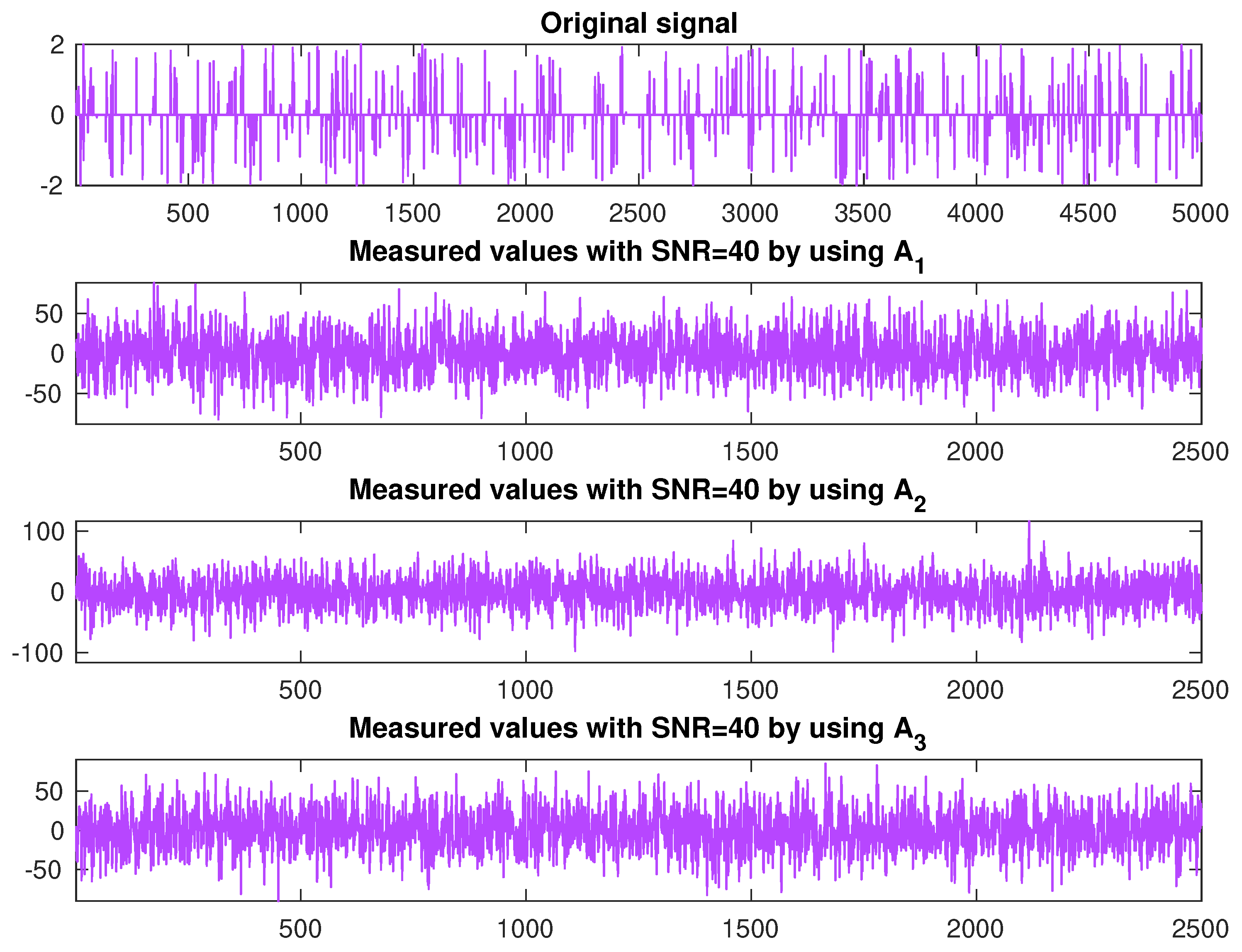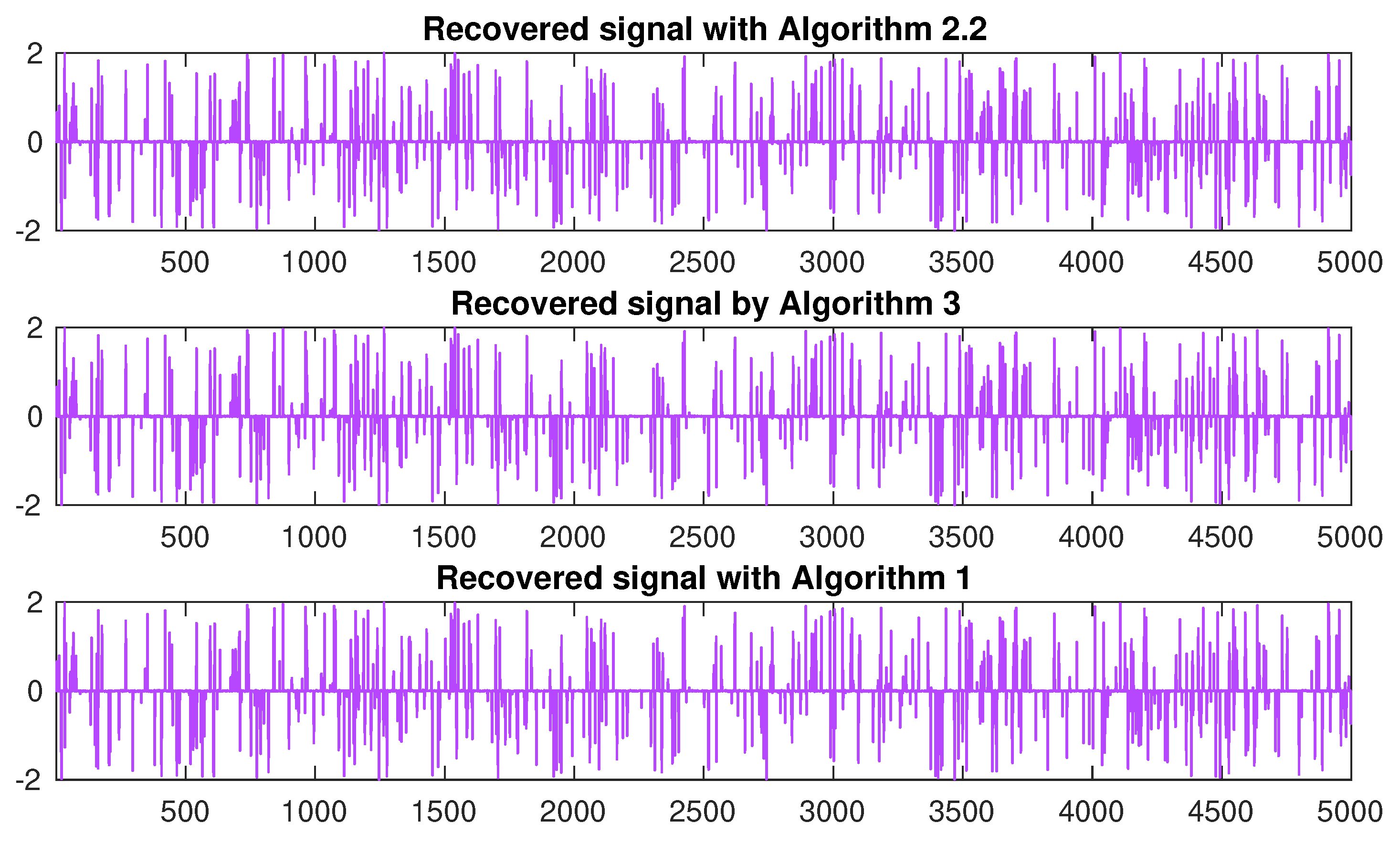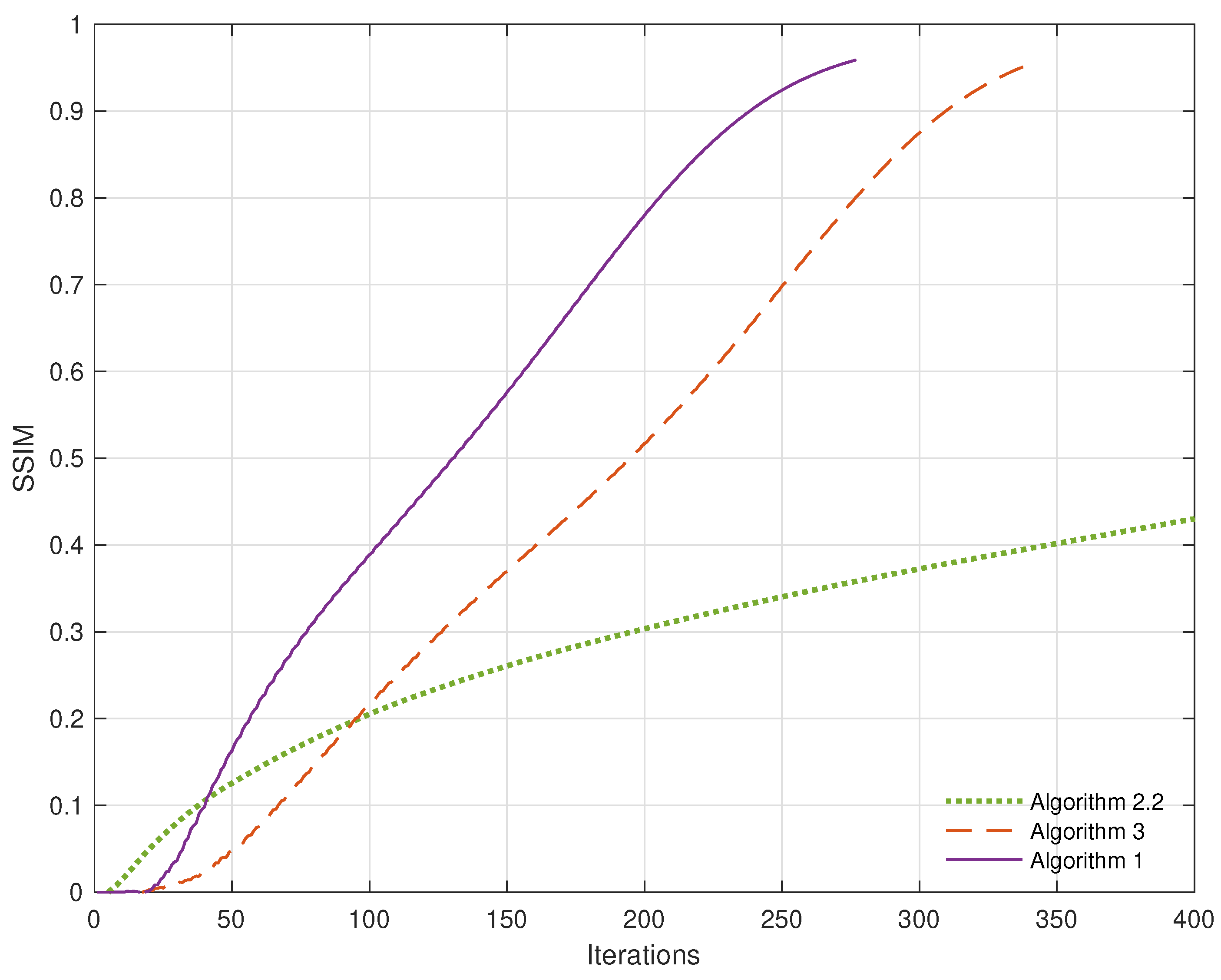Refined Iterative Method for a Common Variational Inclusion and Common Fixed-Point Problem with Practical Applications
Abstract
1. Introduction
2. Preliminaries
- (i)
- The sequence given byis nondecreasing and
- (ii)
- For all , and
- (i)
- for all and all ;
- (ii)
- is closed and convex.
3. Main Result
- (C1)
- Each is -Lipschitz and monotone, and each is maximally monotone.
- (C2)
- is a sequence in such that and .
- (C3)
- Each is -demicontractive, and the map is differentiable.
- (C4)
- is nonempty.
- (C5)
- is a sequence in , and for some .
- (C6)
- is demiclosed at zero and for all .
- (C7)
- for some , , and is -contractive.
| Algorithm 1 Modified parallel algorithm. |
|
4. Signal Restoration from Blurred Observations in the Context of Image Processing
- -
- The signal size is set to and .
- -
- The original signal x is generated from a uniform distribution in with m nonzero elements.
- -
- The Gaussian matrix is generated using the command .
- -
- The observation is generated by adding white Gaussian noise with a signal-to-noise ratio (SNR) of 40.
- -
- The initial points are random vectors, and for all .
- (i)
- Algorithm 2.2: .
- (ii)
- Algorithm 3: and
- (iii)
- Algorithm 1: and
5. Conclusions
Author Contributions
Funding
Data Availability Statement
Conflicts of Interest
References
- Suantai, S.; Kankam, K.; Cholamjiak, P.; Cholamjiak, W. A parallel monotone hybrid algorithm for a finite family of G-nonexpansive mappings in Hilbert spaces endowed with a graph applicable in signal recovery. Comput. Appl. Math. 2021, 40, 145. [Google Scholar] [CrossRef]
- Suparatulatorn, R.; Chaichana, K. A strongly convergent algorithm for solving common variational inclusion with application to image recovery problems. Appl. Numer. Math. 2022, 173, 239–248. [Google Scholar] [CrossRef]
- Mouktonglang, T.; Poochinapan, K.; Suparatulatorn, R. A parallel method for common variational inclusion and common fixed point problems with applications. Carpathian J. Math. 2023, 39, 189–200. [Google Scholar] [CrossRef]
- Lions, P.L.; Mercier, B. Splitting algorithms for the sum of two nonlinear operators. SIAM J. Numer. Anal. 1979, 16, 964–979. [Google Scholar] [CrossRef]
- Passty, G.B. Ergodic convergence to a zero of the sum of monotone operators in Hilbert space. J. Math. Anal. Appl. 1979, 72, 383–390. [Google Scholar] [CrossRef]
- Moudafi, A.; Oliny, M. Convergence of a splitting inertial proximal method for monotone operators. J. Comput. Appl. Math. 2003, 55, 447–454. [Google Scholar] [CrossRef]
- Tseng, P. A modified forward-backward splitting method for maximal monotone mappings. SIAM J. Control. Optim. 2000, 38, 431–446. [Google Scholar] [CrossRef]
- Lorenz, D.A.; Pock, T. An inertial forward-backward algorithm for monotone inclusions. J. Math. Imaging Vis. 2015, 51, 311–325. [Google Scholar] [CrossRef]
- Cholamjiak, W.; Cholamjiak, P.; Suantai, S. An inertial forward-backward splitting method for solving inclusion problems in Hilbert spaces. J. Fixed Point Theory Appl. 2018, 30, 42. [Google Scholar] [CrossRef]
- Gibali, A.; Thong, D.V. Tseng type methods for solving inclusion problems and its applications. Calcolo 2018, 55, 49. [Google Scholar] [CrossRef]
- Abubakar, J.; Kumam, P.; Garba, A.I.; Abdullahi, M.S.; Ibrahim, A.H.; Sitthithakerngkiet, K. An inertial iterative scheme for solving variational inclusion with application to Nash-Cournot equilibrium and image restoration problems. Carpathian J. Math. 2021, 37, 361–380. [Google Scholar] [CrossRef]
- Cholamjiak, P.; Hieu, D.V.; Cho, Y.J. Relaxed forward-backward splitting methods for solving variational inclusions and applications. J. Sci. Comput. 2021, 88, 85. [Google Scholar] [CrossRef]
- Suparatulatorn, R.; Cholamjiak, W.; Gibali, A.; Mouktonglang, T. A parallel Tseng’s splitting method for solving common variational inclusion applied to signal recovery problems. Adv. Differ. Equ. 2021, 2021, 492. [Google Scholar] [CrossRef]
- Suantai, S.; Cholamjiak, W.; Cholamjiak, P. Strong convergence theorems of a finite family of quasi-nonexpansive and Lipschitz multi-valued mappings. Afr. Mat. 2015, 26, 345–355. [Google Scholar] [CrossRef]
- Anh, P.K.; Hieu, D.V. Parallel and sequential hybrid methods for a finite family of asymptotically quasi ϕ-nonexpansive mappings. J. Appl. Math. Comput. 2015, 48, 241–263. [Google Scholar] [CrossRef]
- Cholamjiak, W.; Khan, S.A.; Yambangwai, D.; Kazmi, K.R. Strong convergence analysis of common variational inclusion problems involving an inertial parallel monotone hybrid method for a novel application to image restoration. Revista de la Real Academia de Ciencias Exactas. Físicas Nat. Ser. A Matemát. 2020, 114, 99. [Google Scholar]
- Eslamian, M. Strong convergence theorem for common zero points of inverse strongly monotone mappings and common fixed points of generalized demimetric mappings. Optimization 2021, 71, 4265–4287. [Google Scholar] [CrossRef]
- Eslamian, M.; Kamandi, A. A novel algorithm for approximating common solution of a system of monotone inclusion problems and common fixed point problem. J. Ind. Manag. Optim. 2021, 19, 868–889. [Google Scholar] [CrossRef]
- Wairojjana, N.; Younis, M.; Rehman, H.U.; Pakkaranang, N.; Pholasa, N. Modified viscosity subgradient extragradient-like algorithms for solving monotone variational inequalities problems. Axioms 2020, 9, 118. [Google Scholar] [CrossRef]
- Antón-Sancho, Á. Fixed points of automorphisms of the vector bundle moduli space over a compact Riemann surface. Mediterr. J. Math. 2024, 21, 20. [Google Scholar] [CrossRef]
- Beck, A.; Teboulle, M. A fast iterative shrinkage-thresholding algorithm for linear inverse problems. SIAM J. Imaging Sci. 2009, 2, 183–202. [Google Scholar] [CrossRef]
- Shehu, Y.; Cholamjiak, P. Iterative method with inertial for variational inequalities in Hilbert spaces. Calcolo 2019, 56, 4. [Google Scholar] [CrossRef]
- Mouktonglang, T.; Suparatulatorn, R. Inertial hybrid projection methods with selection techniques for split common fixed point problems in Hilbert spaces. Univ. Politeh. Buchar. Sci. Bull. Ser. A 2022, 54, 47–54. [Google Scholar]
- Kesornprom, S.; Cholamjiak, P. A modified inertial proximal gradient method for minimization problems and applications. AIMS Math. 2022, 7, 8147–8161. [Google Scholar] [CrossRef]
- Peeyada, P.; Suparatulatorn, R.; Cholamjiak, W. An inertial Mann forward-backward splitting algorithm of variational inclusion problems and its applications. Chaos Solitons Fractals 2022, 158, 112048. [Google Scholar] [CrossRef]
- Kabukçuoğlu, A.; Martínez-García, E. A Generalized Time Iteration Method for Solving Dynamic Optimization Problems with Occasionally Binding Constraints. Comput. Econ. 2021, 58, 435–460. [Google Scholar] [CrossRef]
- Zheng, T.; Bergin, M.H.; Hu, S.; Carlson, D.E. Estimating ground-level PM2.5 using micro-satellite images by a convolutional neural network and random forest approach. Atmos. Environ. 2020, 230, 117451. [Google Scholar] [CrossRef]
- Doreswamy, H.; Harishkumar, K.S.; Yogesh, K.M.; Ibrahim, G. Forecasting Air Pollution Particulate Matter (PM2.5) Using Machine Learning Regression Models. Procedia Comput. Sci. 2020, 171, 2057–2066. [Google Scholar] [CrossRef]
- Gokul, P.R.; Mathew, A.; Bhosale, A.; Nair, A.T. Spatio-temporal air quality analysis and PM2.5 prediction over Hyderabad City, India using artificial intelligence techniques. Ecol. Inform. 2023, 76, 102067. [Google Scholar] [CrossRef]
- Mathew, A.; Gokul, P.R.; Raja Shekar, P.; Arunab, K.S.; Ghassan Abdo, H.; Almohamad, H.; Abdullah Al Dughairi, A. Air quality analysis and PM2.5 modelling using machine learning techniques: A study of Hyderabad city in India. Cogent Eng. 2023, 10, 2243743. [Google Scholar] [CrossRef]
- Xu, H.K. Iterative algorithms for nonlinear operators. J. Lond. Math. Soc. 2002, 66, 240–256. [Google Scholar] [CrossRef]
- Maingé, P.E. Strong convergence of projected subgradient methods for nonsmooth and nonstrictly convex minimization. Set-Valued Anal. 2008, 16, 899–912. [Google Scholar] [CrossRef]
- Goebel, K.; Kirk, W. Topics in Metric Fixed Point Theory; Cambridge Studies in Advanced Mathematics; Cambridge University Press: Cambridge, UK, 1990; Volume 28. [Google Scholar]
- Marino, G.; Xu, H.K. Weak and strong convergence theorems for strict pseudo-contractions in Hilbert spaces. J. Math. Anal. Appl. 2007, 329, 336–346. [Google Scholar] [CrossRef]
- Browder, F.E. Nonlinear maximal monotone operators in Banach space. Math. Ann. 1968, 175, 89–113. [Google Scholar] [CrossRef]
- Bauschke, H.H.; Combettes, P.L. Convex Analysis and Monotone Operator Theory in Hilbert Spaces; CMS Books in Mathematics: New York, NY, USA, 2011. [Google Scholar]
- Brézis, H. Opérateurs Maximaux Monotones et Semi-groupes de Contractions dans les Espaces de Hilbert; Mathematical Studies: Amsterdam, The Netherlands, 1973; Volume 5. [Google Scholar]
- Tan, B.; Zhou, Z.; Li, S. Viscosity-type inertial extragradient algorithms for solving variational inequality problems and fixed point problems. J. Appl. Math. Comput. 2022, 68, 1387–1411. [Google Scholar] [CrossRef]
- Liu, H.; Yang, J. Weak convergence of iterative methods for solving quasimonotone variational inequalities. Comput. Optim. Appl. 2020, 77, 491–508. [Google Scholar] [CrossRef]
- Combettes, P.L.; Wajs, V.R. Signal recovery by proximal forward-backward splitting. Multiscale Model. Simul. 2005, 4, 1168–1200. [Google Scholar] [CrossRef]
- Wang, Z.; Bovik, A.C.; Sheikh, H.R.; Simoncelli, E.P. Image quality assessment: From error visibility to structural similarity. IEEE Trans. Image Process. 2004, 13, 600–612. [Google Scholar] [CrossRef]

Disclaimer/Publisher’s Note: The statements, opinions and data contained in all publications are solely those of the individual author(s) and contributor(s) and not of MDPI and/or the editor(s). MDPI and/or the editor(s) disclaim responsibility for any injury to people or property resulting from any ideas, methods, instructions or products referred to in the content. |
© 2024 by the authors. Licensee MDPI, Basel, Switzerland. This article is an open access article distributed under the terms and conditions of the Creative Commons Attribution (CC BY) license (https://creativecommons.org/licenses/by/4.0/).
Share and Cite
Thangthong, C.; Suparatulatorn, R.; Chaobankoh, T.; Chaichana, K. Refined Iterative Method for a Common Variational Inclusion and Common Fixed-Point Problem with Practical Applications. Axioms 2024, 13, 740. https://doi.org/10.3390/axioms13110740
Thangthong C, Suparatulatorn R, Chaobankoh T, Chaichana K. Refined Iterative Method for a Common Variational Inclusion and Common Fixed-Point Problem with Practical Applications. Axioms. 2024; 13(11):740. https://doi.org/10.3390/axioms13110740
Chicago/Turabian StyleThangthong, Chaiporn, Raweerote Suparatulatorn, Tanadon Chaobankoh, and Khuanchanok Chaichana. 2024. "Refined Iterative Method for a Common Variational Inclusion and Common Fixed-Point Problem with Practical Applications" Axioms 13, no. 11: 740. https://doi.org/10.3390/axioms13110740
APA StyleThangthong, C., Suparatulatorn, R., Chaobankoh, T., & Chaichana, K. (2024). Refined Iterative Method for a Common Variational Inclusion and Common Fixed-Point Problem with Practical Applications. Axioms, 13(11), 740. https://doi.org/10.3390/axioms13110740










